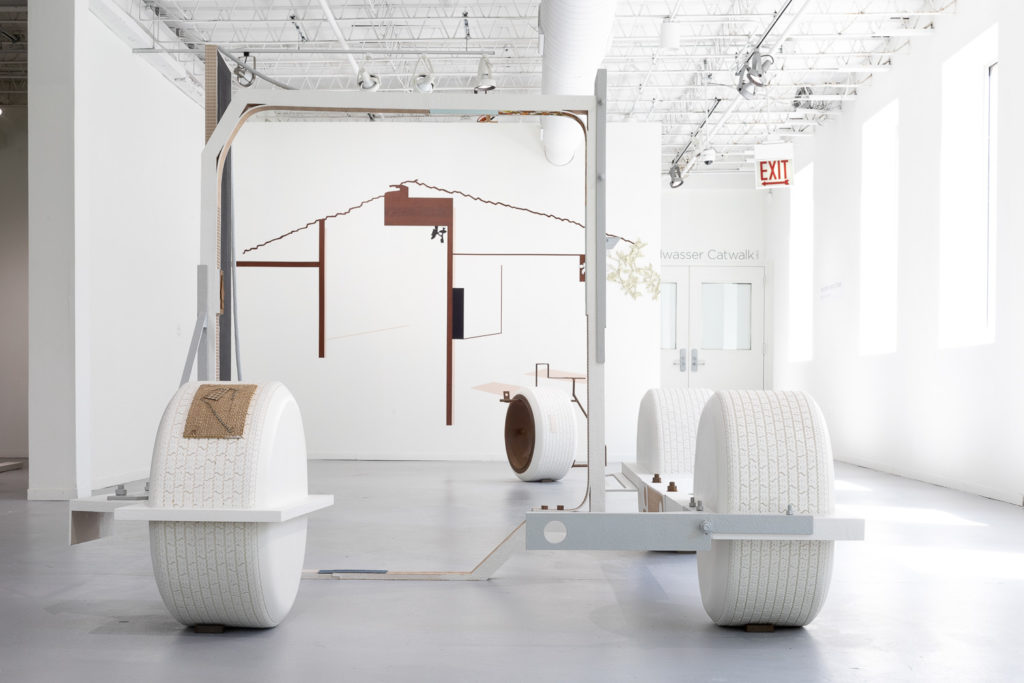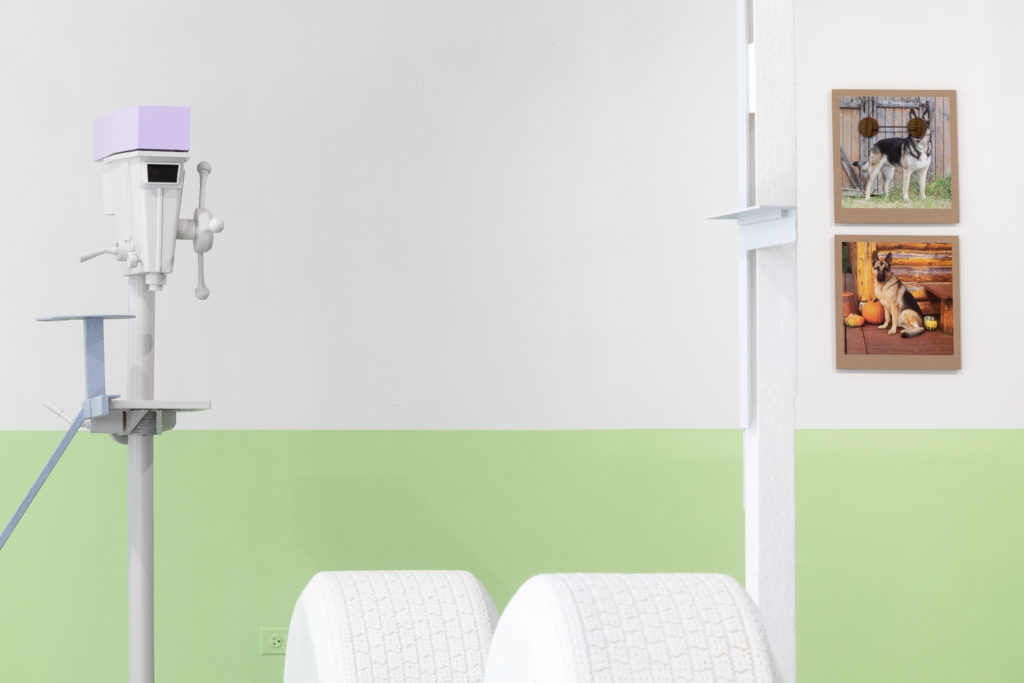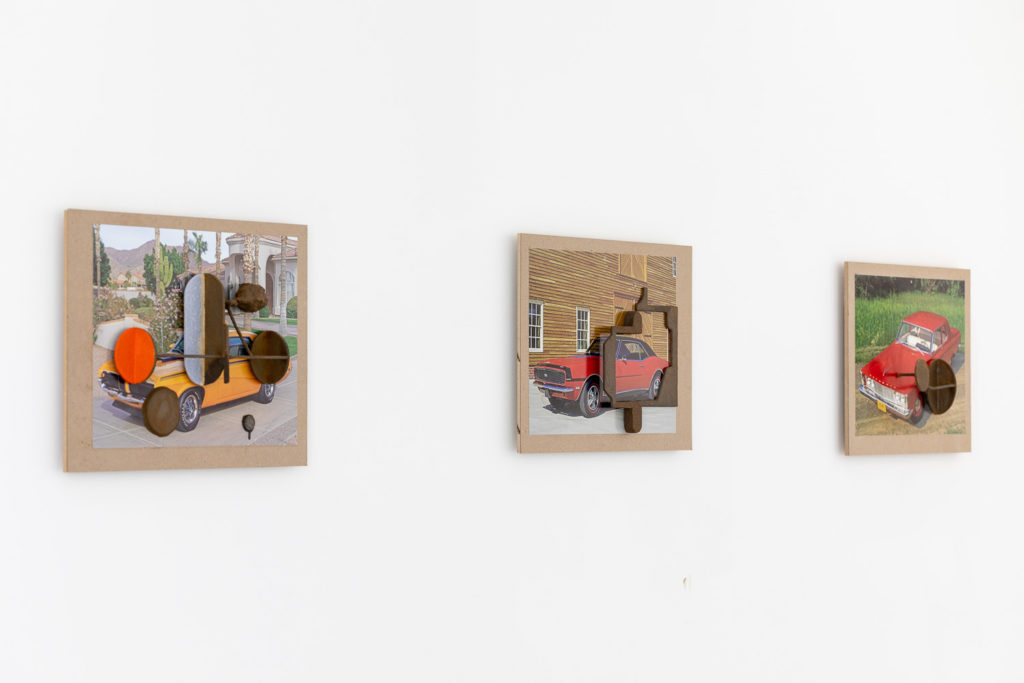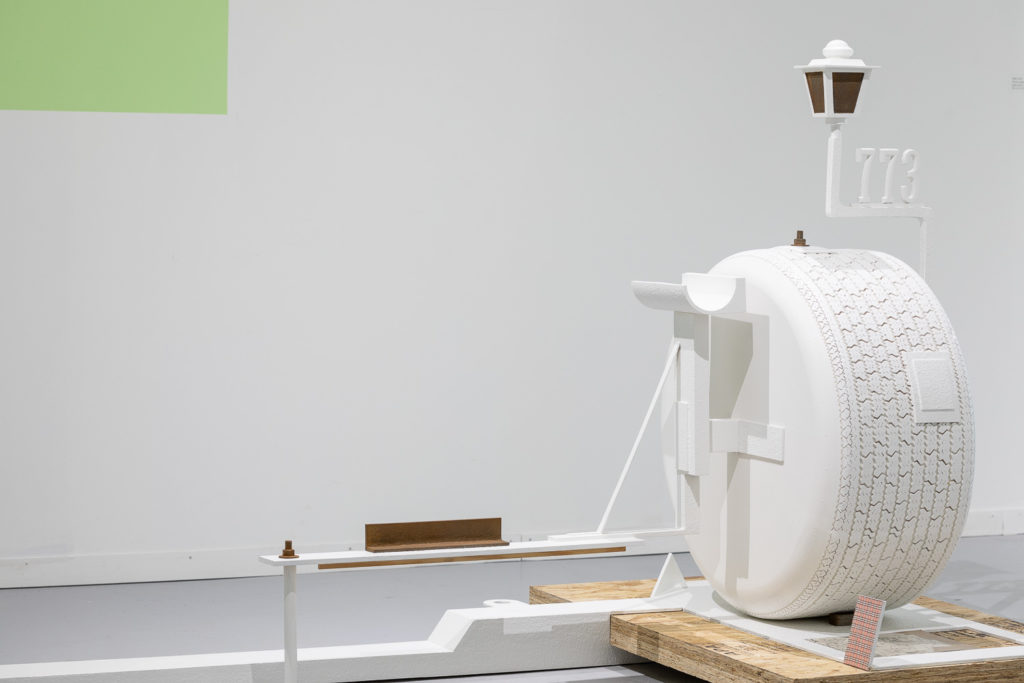Uncanny Cars: Steve Reber’s Anemic Compass
by Bert Geyer
Assemblage is classified as an additive process within the methodology of sculpture, combined parts produce a sum. The assemblages in Steve Reber’s exhibition, Anemic Compass, at the Hyde Park Art Center are additive in construction yet subtractive in effect. Rather than creating frankenobjects, the exhibition assumes the object to which it is attending—the car—is already a frankenobject. Such intricate machines beckon assemblage as an apt formal mode to display the sophistication of their part-to-whole relationships. This show flaunts that expectation and uses assemblage otherwise. It does not offer the holistic satiety of countless gadgets unifying under a shared objective, like the meshing of multi-geared differentials. Fascination with connection is transferred to the less immediately tangible, but nonetheless deeply material, dynamics of production and consumption which cars entangle. This prolapses the haptic coherence of cars for an apprehension of the car as a diffuse phenomenon. The subtractive effect is breaking the reification of automobiles.

The primary materials of the sculptures are wood, various wood composites, and plaster, yet their surface treatments belie this composition. Many surfaces are coated with a rusty finish the artist identifies as “iron surfacer.” That this rust is applied, not corroding, shifts attention from observing deterioration to contemplating the signification of rust. With the historic prominence of car and steel manufacturing in the U.S. economy, rust has become a common metonym in the nostrums of mainstream American political discourse. Its various utterances are often contending with the fate of twentieth century industrial progressivism—the ideological belief that industrial development will guarantee a better future. A phrase like “Rust Belt” simultaneously hails the gritty mien of industrial workers and mourns their excoriated futures. Forge/Finding the sun (2019) succinctly expresses this notion of industrial decline marked with national sentiment through a rusty five-pointed star anchor plate bolted to a rust encrusted dowel, likely standing-in for an axle. It is no coincidence that historic modelmaking and faux antique styles also commonly use this finish. The hobby and style’s shared tendency toward cathected nostalgia is extended to the rust trope. An allusion to Icarus in the title characterizes this nostalgia as seeking recuperation of a once-future by amending the tragic flaw. The hubris of industry allowed its aspirations to melt in the heat of the blast furnace. There is plenty hubris; it is redolent in that pertinent and odious phrase, the American century. But the flaw is not that old admonishing chestnut that technology brought us too close to the heavens. It is the thought that it ever could.
Excepting a few, the surfaces without superficial rust are painted white. It is a classicizing effect that complements and contrasts with the rust. Each are memorializing tropes imparting a monochrome tone to history—one ossifying for posterity, the other oxidizing to ruin, both heroizing. Again, there is abundant reason to sense mendacity in such a rendering. The historical whitewashing of classical polychromy comes to mind. By applying these memorializing tints superficially and foiling them with one another, the exhibition scrutinizes their sentimentality and refuses an operation which presumes an affect as intrinsic to an object or its history.
Both Area (2019) and Auto Mending/7 miles behind (2018) incorporate 1:1 plaster tires. Though the mold for the casts was presumably formed on an actual tire, the material and color translation estrange the casts from the everyday object. The verisimilitude of the treads is uncanny. Patches adhere to some of the tires and adroitly utilize an aspect of the subject matter, routine car maintenance, to emphasize that tires are a textile. Contemplating tire manufacturing throws one across an immense scalar continuum, from the precision of radially laminated elastomer and cord plys to the vastness of fraught political economy entailed in their production, historically and now. Beginning with colonial enslavement of indigenous people in the Amazon Basin, through coercive labor conditions of imperial and corporate operations such as British rubber plantations in Malaysia or the Brazilian company town, Fordlândia, and all the while advancing rampant deforestation and ecologically precarious monocultures. Now synthetic rubber is polymerized from petroleum, another commodity yielding unbridled incursions on sovereignty, environmental depredation, and hazardous labor. To consider the tire is not just to comprehend its complexity, but to recognize that rusty and marmoreal elegies are for an industrialism which never was and remains not what it is construed to be.

Sustaining such mobilizations requires reciprocal capital and infrastructural development to flow into environments of consumption. While people and ecosystems of South America slot into roles of raw material resource for production, U.S. highways and federal and state lands fashion themselves as objects of desire for a consumerist gaze. A low plaster wall in Forge/Finding the sun suggests this notion through a sculptural portmanteau of a car door and pebble masonry footing endemic to the signage of so many national parks and suburban developments. This fusion insists that the car and the landscape through which it travels coproduce each other.
Go it alone (2019) and Auto Mending/7 miles behind limn this environment of consumption closer to home. In fact, it is home. The former is a vinyl wall drawing delineating a spare cutaway projection suggestive of a house, or maybe the garage annex of a house. Yet the pitched lines forming the roof are serrated and disjunctively flattened out of the perspective of the rest of the drawing. Their signification vacillates between a gable and the jagged silhouette of a mountain. Auto Mending/7 miles behind’s proximity to Go it alone completes the ternary conflation of car, home, and landscape. Fabric swatches of various patterns line the inside of an austere frame suggesting a car interior as it sits atop an imagined chassis indicated by the spacing of the tires. These options of surface, alongside a house rendered in vinyl wood veneer, impresses the consumer isomorphism between cars and homes. Pick any flavor of interior to identify your taste and situate yourself within the hierarchy of price points, so long as you consume a mechanism finely tuned to the propagation of capital.
Area presents the ultimate result of this this ternary conflation, the subdivision. Street address numerals and a front door sconce are affixed to a tire. The tire stands on laminated sheets of oriented strand board (OSB) that are conspicuously unsurfaced. The OSB’s pressed wood chips and certifying stamps index homebuilding’s industrialization. On this platform lies a line drawing of numerous Disney characters. The juxtaposition aligns houses not just with fantasy but the industry of fantasy. After the Great Recession, it is painfully clear that the concrete figure of the house, and the autonomy consummated through its ownership, liquidates under the finance speculation of subprime mortgages. Similarly, the duplicitous dream of the car’s open road was shown to be beholden to the perverse mercy of TARP funds buttressing auto companies with little relief for their customers and non-executive employees.

Desire is most palpable in 1 Calendar (2019), a series of twelve image reliefs hung in an ancillary room. Each relief appends a sort of handle with an irregularly ramifying geometry to a photograph of a car excised from a calendar. All the photographs share the same pin-up composition, a car lasciviously plopped in the center of the frame fronting backgrounds of homes or road landscapes which flesh out the pleasures of the wanton object. That they are all American muscle cars not only amplifies the libidinal tone but makes salient the car’s slippery appeal to disparate, yet not necessarily mutually exclusive, masculine fantasies. It can be a feminine object for a doting masculine subject—so much waxing and rubbing. Or it can be the surrogate mechanical body of tumescent metal and stentorian annunciation to supplant supple corporeality. This latter chauvinist fantasy is savored in the manifestos of the Italian futurist, Filippo Tommaso Marinetti, which also idolize national industrial progressivism such that it is no wonder the reliefs springing forth from the images are covered in rust. Whatever the object of desire, the handles intimate a yearning to grasp the pleasures a car reifies while simultaneously dispersing this grasp through rusty circuits and nodes so that it never lays hold of its object.
Facsimile/Fade to white (2018), a skeuomorph of a drill press, stands on its own integrated plinth in a corner of the gallery. It is procedurally congruent with the other sculptures in that it replicates another object, but it is a complete copy and not a conglomerate with some replicated parts. Further, other works incorporate minor plinths and pedestals, but none rest entirely within these sculptural framing devices. An ars poetica arises from this adjacency. The drill press accentuates the distinction between the exhibition’s conditions of production and that of cars. Artisanal labor with familiar and readily available tools and materials is foiled with the implicit assembly line of customized robots and industrial workers. This is not to take up the mantle of myriad YouTube channels and Instagram accounts fetishizing craftmanship or personality as an escape from alienated labor, an unenviable exacerbation of commoditizing one’s discrete hours of labor to commoditizing one’s whole way of life. Instead the ars poetica indicates the position of the artist negotiating the macro-dynamics the show engages as they refract through the specificity of his own individual life. Perhaps this is why some details seem so particular as to be idiosyncratic, such as the piece of toast in Forge/Finding the Sun or the German Shepherd photographs in Shepherd (2018).
Anemic Compass addresses the legacy of the car in a manner that would likely strain the narrative and chronological proclivities of historiography. It offers assemblage as a complementary mode which demonstrates how diachronic relations are also synchronic. How cause and effect slip over each other, and other causes and effects, and render a dense coevality to the events which constitute the legacy of cars pervading the present and future. This simultaneity not only happens within the assemblages but amidst them too. They quote and implicate one another causing their discrete boundaries to diffuse, like the fourth wheel of Auto Mending/7 miles behind which has rolled away from its chassis and rests before Go it alone and Port (2019).

Diego Rivera’s 1933 Detroit Industry fresco cycle seems a precedent for Anemic Compass. Each work is less interested in the car as such and more focused upon the inordinate series of relations that a car engenders. And there is astonishing difference in what cars register then and now. Rivera depicts the exploitation of industrial workers, indigenous peoples, and ecosystems while also imbuing factory scenes with the salutary possibility of intersectional collectivity that could liberate the proletariat. Some eighty years later, Anemic Compass diagnoses the sickliness in the lodestone of industrial progressivism, whether capitalist or socialist. While it tracks mass production as Rivera did, it also has the vantage of the intervening decades in which reciprocal upheavals in consumption have permeated our psychic and material lives to maintain the dubious trajectory of industrial progress.
The specter of climate change looms with any broaching of cars and their materiality. The exhibition coyly sidesteps the obvious to coax out more subtle ways in which cars and, by extension, industrialism enfold us. Sweeping societal conversion to carbon neutrality is urgent and requires the scalar reach of industry. However, to solely upgrade to industrial progressivism 2.0 is to overlook the mendacious sway technology often holds as, by definition, a causal agent for a better future. Rather than aver a reactionary and equally pernicious primitivism, Anemic Compass estranges the material culture of industrialism to postpone its instrumentalizing promise so that we may consider the conditions of that promise.
Steve Reber: Anemic Compass runs at the Hyde Park Art Center until June 16, 2019.